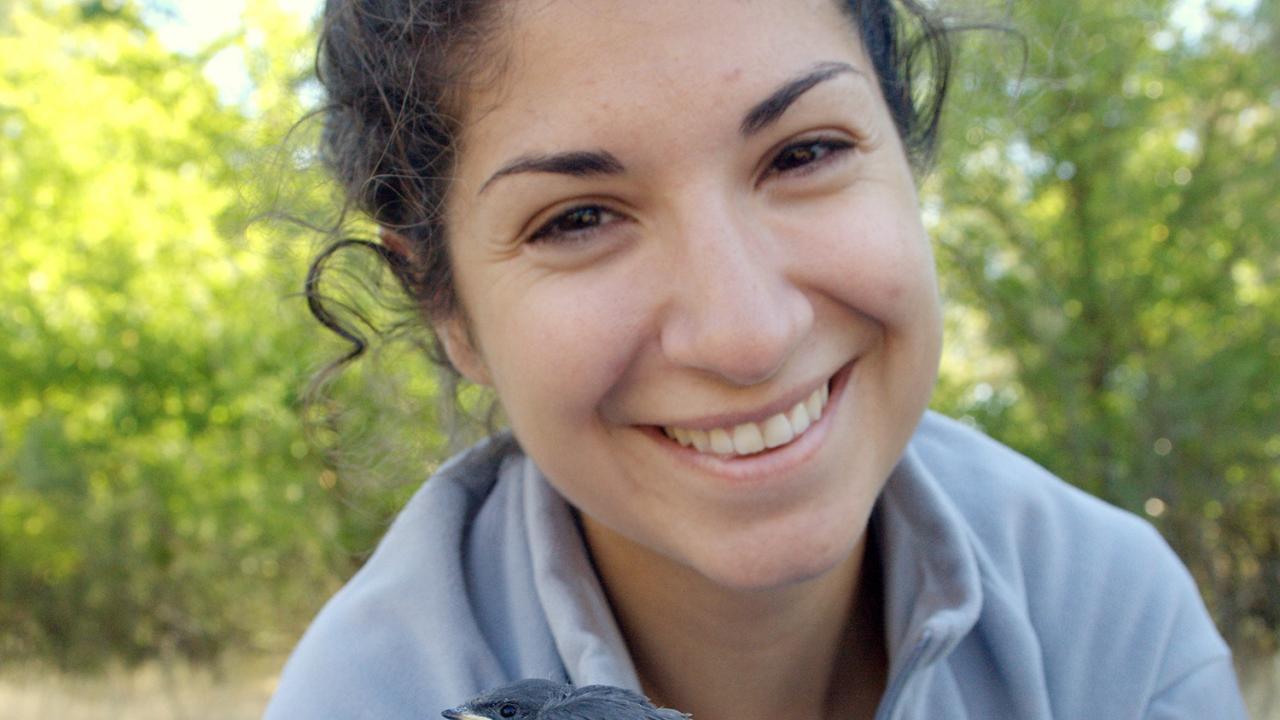
Allison Injaian, ’18 Ph.D. in Animal Behavior: Studying Impacts of Noise Pollution on Tree Swallows
Quick Summary
- Allison Injaian is a recent Ph.D. graduate who studied in Professor Gail Patricelli's lab
- Injaian studies the effects of traffic noise on tree swallows
- In the fall, she'll start work as a postdoctoral associate in the Cornell University Lab of Ornithology
As a master’s student at the University of Michigan, Allison Injaian studied the behaviors of a unique species of wasp. Named Polistes fuscatus, these wasps—much like humans—recognize one another based on facial markings. For an organism with such a tiny brain compared to humans, the mastery of such specialized visual learning was described by Injaian’s advisor and lab mentor Professor Elizabeth Tibbetts as “surprising and sort of bizarre.”
“We were trying to understand how and why that evolved in wasps,” said Injaian, who recently received a Ph.D. in Animal Behavior from UC Davis. “From that, I realized that I enjoyed the behavior aspects of that research, but I wanted to do something more conservation-focused for my Ph.D.”
That desire led Injaian to UC Davis, and more specifically, to the lab of Professor Gail Patricelli, Department of Evolution and Ecology and the Center for Population Biology.
Tree swallows and traffic
In the Patricelli Lab, Injaian focused her research on the impacts of traffic noise on the tree swallow, a small song bird found throughout North America that nests near rivers and creeks and eats aquatic insects.
“Traffic noise is really widespread,” said Injaian. “Even if you’re in an area that’s not near the road itself, you can still hear noise from afar.”
To test the effects of traffic noise, Injaian identified a population of tree swallows cutoff from the roar of the road. Using speakers and amplifiers, she conducted an experiment which exposed some birds to traffic noise but kept other birds away from the noise.
“If you study birds that are nesting near the road, you don’t know whether any negative impacts are because of the noise, because of the light pollution that’s associated with the road, because of the exhaust from cars, and so on,” Injaian said. “You can’t really isolate out what it is about the road that could be causing the negative effects.”
Injaian found that tree swallows exposed to noise experienced a suite of negative impacts. They laid fewer eggs, and the nestlings that did hatch had lower body mass and reduced feather growth.
In a separate experiment, Injaian found increased levels of corticosterone, an avian stress hormone, in the birds exposed to traffic noise. She is currently in the process of publishing her findings. “It doesn’t give you the whole picture of the stress response, but it can give you some indication that these birds are having physiological impacts because of the noise exposure,” she said.

Mentoring undergraduate researchers
Part of the appeal of working with tree swallows for Injaian was their proximity to UC Davis’ campus. This allowed valuable research opportunities for the undergraduates Injaian mentored while earning a Ph.D. degree.
“With a lot of field research, you go away to these different locations and you’re there for two, three months while you’re conducting your experiments,” she said. “That makes it really hard for undergrads to be involved because they need to take classes.”
While at UC Davis, Injaian mentored close to 30 undergraduates, most of whom served as field interns, accompanying Injaian to field sites and helping her collect data. “It’s made me feel more like a part of the UC Davis community,” she said of her mentorship experience. “I really enjoy helping people who are in the very early stages of the scientific careers.”
Injaian noted mentorship was a skill she developed during her Animal Behavior Ph.D. program. She praised Patricelli for teaching her how to mentor undergraduate students and noted the benefits of being a Professors for the Future Fellow, a year-long fellowship designed to help graduate students develop leadership skills.
“Part of the reason I knew I wanted to mentor was because mentorship had an impact on my trajectory,” she said.
Part of Injaian’s research funding came from the College of Biological Sciences Dean’s Mentorship Award, which recognized her efforts to help support research opportunities for undergraduates.

Migrating east
In fall 2018, Injaian will build on her Ph.D. research as a postdoctoral associate at the Cornell University Lab of Ornithology, one of the world’s premiere institutes for avian research
“I’ll still be working with tree swallows but we’re going to look at the effects of simultaneous noise and light pollution and how that affects hormones associated with stress and immune responses, and different measures of reproductive success,” Injaian said.
A new component of her research, which doesn’t involve birds as subjects but still concerns soundscapes, will examine how far noise travels at different levels in forests.
“All of those plant surfaces can reflect the noise,” Injaian said. “Birds nesting on the ground could potentially be exposed to more or less noise than the birds nesting higher up in the trees just based on the way noise propagates through these complex habitats.”
Developing this information could help conservationists better understand how to protect bird species living in noisy environments.
